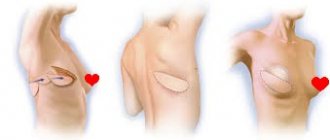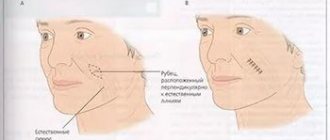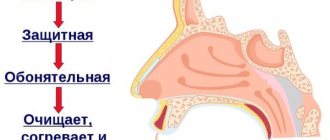- home
- Articles on ENT diseases
- Chondrolaryngoplasty - removal of the Adam's apple and feminization of the voice
Since April 2020, the clinic has suspended accepting patients for an indefinite period.
We apologize. The Adam's apple very often causes a lot of trouble for transsexuals, but the solution to this problem is achieved by removing, reducing the size of the Adam's apple, or if complete removal of the Adam's apple is not possible, changing the angle of the thyroid cartilage to 120 degrees (female type) instead of 90 degrees (male type).
Why is it necessary to remove the Adam's apple during vocal feminization?
Direct feminization of the voice, i.e. Changing the timbre of the voice to a female one is achieved through a simple endoscopic operation to thin or shorten the vocal cords. Endoscopic surgery is most preferable due to its minimal invasiveness and gentle technique for patients.
However, the part of the larynx protruding on the front surface of the neck - the Adam's apple or Adam's apple - causes aesthetic dissatisfaction and psychological discomfort to patients.
Removing or reducing the Adam's apple (also called chondrolaryngoplasty or thyroplasty) effectively solves this problem. During this operation, the Adam's apple is trimmed - the front part of the thyroid cartilage and the throat is given a more feminine appearance:
To perform operations to remove the Adam's apple and feminize the voice, you need highly qualified personnel with experience in performing such operations and an ENT clinic well equipped with modern equipment. The operation must be performed with very high quality, since significant intervention in the structure of the larynx implies a significant change in the quality of the voice subsequently.
Before surgery to change your voice to a female voice, we always take x-rays of the thyroid cartilage and vocal cords and measure the exact distance from the vocal cords to the top of the Adam's apple. This way, we can remove as much tissue as possible from the Adam's apple without risking damage to the vocal cords.
As a result of the operation, the protrusion (Adam's apple) of the front surface of the neck is eliminated, the surgical scar is not noticeable and coincides with the natural folds of the skin.
Low-traumatic surgery on the ligaments will restore your voice and self-confidence
A pleasant voice attracts the affection of others. But not everyone is given this advantage by nature. And over time, formations may appear on the ligaments, further interfering with the clear sound of the voice. Fortunately, it is possible not only to return it, but also to change it through surgery.
Reasons for surgery on the ligaments
Surgical manipulations on the ligaments are possible for several reasons:
- due to scars formed due to injury or after surgery on the larynx and neighboring organs;
- for polyps, cysts, granulomas, nodes on them;
- if necessary, restore conversational abilities reduced after tumor removal;
- due to partial or complete paralysis of the ligaments;
- due to age-related changes in voice modulation;
- when it sounds rude to a woman;
- when men's voices are too high.
In most cases, the need for surgery is purely medical. The patient needs to restore his voice, as it sounds too quiet, slurred, and becomes hoarse. And after a long conversation, you feel tired, which also affects its quality. This makes communication difficult and can interfere with the performance of professional duties.
But surgery can also be done if you simply don’t like your own voice. Rejection of its sound does not harm your health, but it causes psychological discomfort, which is not far from somatic diseases.
We recommend reading about laser septoplasty. You will learn about the indications for surgery, the technique of performing it, the rehabilitation period, and possible undesirable consequences. And here is more information about rhinoplasty of the tip of the nose.
Diagnosis of ligament condition
An examination for voice problems includes, in addition to interviewing the patient, the following manipulations:
- Laryngoscopy . This is a visual examination of the larynx using a special mirror and laryngeal endoscopes. The doctor will pay attention to the shape of the ligaments, the color of the surface, and the features of the neoplasm, if any.
- Stroboscopy . With its help, ligament movements, static areas, and unwanted changes in vibrations are identified. This is done thanks to light pulses directed at them.
Stroboscopy
Sometimes, for a more accurate diagnosis, a CT scan is prescribed and a biopsy of the tumor is performed.
Methods of performing surgery on the ligaments
The nature of the intervention depends on the problem at hand. It can be performed using a laser or surgical instruments. The use of an endoscope, laryngoscope, and microscope is mandatory. Typically, interventions are performed under general anesthesia due to the difficulty of accessing the ligaments. It is carried out through natural routes, without incisions.
To change your voice
It is possible to make the timbre higher or lower by transforming the chords. The doctor uses instruments to penetrate the larynx to the surgical field. If it is necessary to lower the timbre of the voice, notches are made at certain points of the ligaments. They lengthen and begin to vibrate differently during a conversation. Accordingly, the voice becomes lower.
Before and after ligament lengthening surgery
It is more difficult to transform the original timbre into a higher one. To do this, you need to shorten the ligaments. The procedure for changing them takes longer, it is important not to overdo it so that the voice does not become too thin.
Before and after laser plastic surgery of the ligaments. Blue stars indicate 2 seams; they will dissolve in 2-3 months. Before and after (after 6 months) shortening of the ligaments. The yellow arrow shows the place where the stitches were placed (they dissolved).
To improve your voice
Injection laryngoplasty will help improve your voice, get rid of hoarseness, and make it sound louder. It eliminates muscle atrophy and returns the ligaments to their previous appearance and function.
The intervention is carried out under the control of a laryngoscope. Using a long needle, the ligaments are filled with the patient's own fat tissue taken from other areas.
Sometimes collagen preparations and calcium hydroxyapatite are used as a graft. The ligaments are restored in volume, their elasticity improves, which leads to normalization of the sound of the voice.
But the effect will be present until the graft is absorbed.
Injection of calcium hydroxyapatite into ligaments
Another type of operation is performed for tumors on the ligaments. The resulting growths are removed using microsurgery, sometimes laser or radio wave radiation. If there is a need to get rid of part of the ligament tissue, replacement is carried out with implants.
For information about voice change surgery, watch this video:
Recovery after surgery on the ligaments
Rehabilitation after the intervention should last at least 3 months. It includes several conditions:
- Inhalations The first 2 weeks or 10 days, especially if the operation was accompanied by the removal of formations, you need to remain silent. You can communicate with others using gestures, using paper and pen, or technology.
- In the future, you also need to take care of your voice and talk less. Whispering or speaking in a raised voice should be avoided. In both cases, the load on the ligaments increases.
- You cannot go to the bathhouse or swimming pool. During recovery, it is not advisable to inhale hot and humid air.
- It is necessary to carry out the procedures prescribed by the doctor. This can be irrigation, inhalation, blockade with drugs, infusion of special cocktails.
- Smoking is prohibited for at least the entire postoperative period. It’s better to give up the bad habit completely, otherwise problems with your voice will arise again.
- You should also not drink alcohol. After a glass of wine, the voice seems to sound better, as the elasticity of the ligaments increases for a short time. But in fact, alcohol causes them to become dry.
- Do not eat hot, spicy food. It irritates the mucous membrane, causing dryness.
- Some time after the operation, you should go to a speech therapist. The specialist will teach you a conversation technique that will reduce the load on your ligaments.
We recommend reading about rhinoplasty to correct the nasal septum. You will learn about the causes and types of deformation of the nasal septum, diagnostic preoperative procedures, surgery, and the recovery period after. And here is more information about the rehabilitation period after rhinoplasty.
Preventing the development of ligament problems
It is better to try to prevent changes in voice, soreness, and the appearance of tumors on the ligaments than to treat and operate. Problems can be avoided if:
- learn to speak loudly without straining your ligaments, which is facilitated by special speech techniques;
- avoid high load on them for the first 2 hours after waking up;
- avoid hypothermia and overheating;
- carefully and completely treat pathologies of the larynx and respiratory organs;
- drink plenty of fluids and gargle with soothing herbal infusions (chamomile, calendula, sage);
- stop smoking and eating too much spicy food;
- try to avoid staying in a smoky, dusty room.
A special role in the prevention of diseases of the apparatus belongs to special exercises:
- Pronounce alternately the sounds “i”, “e”, “a”, “o”, “u”, stretching them out as much as possible. The exercise is done in front of a mirror and repeated 3 times.
- Pronounce the sound “m” with closed lips. The first time they do this quietly, then louder, and in the end they increase the sound even more.
- Touch the roof of your mouth with the tip of your tongue and growl, then exhale and make it stronger. The second part of the exercise should be to clearly pronounce words that contain the letter “R” (role, fish, fence, etc.).
- Standing straight, inhale and as you exhale, make the sound “i”, knocking on your chest. Then do the same, pronouncing “e”, “a”, “o”, “u”.
- From the same position, breathe rhythmically. Then take a deep breath, exhale sharply with the sound “ha”.
Sometimes you can restore your voice, give it sonority, or slightly change the timbre using conservative methods. But if they do not help, you should turn to surgery. A timely operation will not only restore your voice, but will also help to avoid more serious problems with the ligaments.
To see what exercises help relax the ligaments, watch this video:
Source: //PlasticInform.com/plasticheskaya-hirurgiya/golova-i-sheya/operatsiya-na-golosovyh-svyazkah.html
Adam's apple removal surgery
- The operation is performed under general anesthesia.
- A 2-4 cm wide incision is made at the level of the middle third of the thyroid cartilage, if possible along the natural skin fold.
- After the incision, the thyroid cartilage is exposed to the perichondrium. It is important not to damage its internal part. The protruding, outer edge of the Adam's apple is removed to the required extent.
- The extrinsic muscles of the larynx, running above and along the Adam's apple, are sutured over the operated surface of the cartilage.
- A cosmetic suture and aseptic dressing are applied.
Preventing the development of ligament problems
It is better to try to prevent changes in voice, soreness, and the appearance of tumors on the ligaments than to treat and operate. Problems can be avoided if:
- learn to speak loudly without straining your ligaments, which is facilitated by special speech techniques,
- avoid high load on them in the first 2 hours after waking up,
- avoid hypothermia and overheating,
- carefully and completely treat pathologies of the larynx, respiratory organs,
- drink plenty of fluids and gargle with soothing herbal infusions (chamomile, calendula, sage),
- quit smoking, a lot of spicy food,
- try to avoid staying in a smoky, dusty room.
A special role in the prevention of diseases of the vocal apparatus belongs to special exercises:
- Pronounce alternately the sounds “i”, “e”, “a”, “o”, “u”, stretching them out as much as possible. The exercise is done in front of a mirror and repeated 3 times.
- Pronounce the sound “m” with closed lips. The first time they do this quietly, then louder, and in the end they increase the sound even more.
- Touch the roof of your mouth with the tip of your tongue and growl, then exhale and make it stronger. The second part of the exercise should be to clearly pronounce words that contain the letter “R” (role, fish, fence, etc.).
- Standing straight, inhale and as you exhale, make the sound “i”, knocking on your chest. Then do the same, pronouncing “e”, “a”, “o”, “u”.
- From the same position, breathe rhythmically. Then take a deep breath, exhale sharply with the sound “ha”.
Sometimes you can restore your voice, give it sonority, or slightly change the timbre using conservative methods. But if they do not help, you should turn to surgery. A timely operation will not only restore your voice, but will also help to avoid more serious problems with the ligaments.
Postoperative period
- As a rule, patients feel pain in the surgical area in the first days.
- Hoarseness and weakening of the voice temporarily appear, which disappear during the healing process.
- The dressing is changed daily to ensure good healing of the surgical wound.
- The swelling gradually decreases. Stitches can be removed after 8-10 days.
If you still have questions about the operation itself or the capabilities of our ENT clinic, ask your question in the form of comments or call our clinic and qualified surgeons will advise you.
Recovery after vocal cord surgery
Rehabilitation after the intervention should last at least 3 months. It includes several conditions:
- For the first 2 weeks or 10 days, especially if the operation was accompanied by the removal of formations, you need to remain silent. You can communicate with others using gestures, using paper and pen, or technology.
- In the future, you also need to take care of your voice and talk less. Whispering or speaking in a raised voice should be avoided. In both cases, the load on the ligaments increases.
- You cannot go to the bathhouse or swimming pool. During recovery, it is not advisable to inhale hot and humid air.
- It is necessary to carry out the procedures prescribed by the doctor. This can be irrigation, inhalation, blockade with drugs, infusion of special cocktails.
- Smoking is prohibited for at least the entire postoperative period. It’s better to give up the bad habit completely, otherwise problems with your voice will arise again.
- You should also not drink alcohol. After a glass of wine, the voice seems to sound better, as the elasticity of the ligaments increases for a short time. But in fact, alcohol causes them to become dry.
- Do not eat hot, spicy food. It irritates the mucous membrane, causing dryness.
- Some time after the operation, you should go to a speech therapist. The specialist will teach you a conversation technique that will reduce the load on your ligaments.
We recommend reading about rhinoplasty to correct the nasal septum. You will learn about the causes and types of deformation of the nasal septum, diagnostic preoperative procedures, surgery, and the recovery period after. And here is more information about the rehabilitation period after rhinoplasty.
Surgery to transform a tenor into a baritone
Reducing the timbre of the voice, according to phonation surgeons, is the simplest operation. To do this, doctors use elongated surgical instruments or a CO2 laser. The surgeon reaches into the ligaments, then makes a small incision in the desired location. Experts say that after this simple manipulation the voice becomes much lower, closer to the bass. It is this timbre that is held in special esteem by professional vocalists.
Initially, vocal cord surgery was performed to restore speech ability in patients who had lost their voice due to some pathology or injury. But recently, such operations have also been carried out for cosmetic purposes - to rid the patient of age-related trembling of the voice, to add a brutal bass voice to a man or to eliminate “low tones” in a woman. Voice timbre is often corrected using special exercises, but rapid significant changes can only be guaranteed by surgical intervention.
Progress of the procedure
Before the operation, the patient is given a diagnosis, during which it is necessary to identify the degree of risk. Diagnostics is carried out in several stages:
- examination of the larynx through a mirror or frontal reflector;
- Using local anesthesia, the ligaments are examined through a flexible optical fiber that is inserted through the nose;
- after this, the patient undergoes stroboscopy - a procedure aimed at identifying dysfunction of the vocal cords or other formations;
- An acoustic test helps to track the voice picture before and after surgery.
The mechanism of the operation itself is determined very individually and depends on the specific situation. The most popular types of operations on the vocal cords are the transformation of a tenor into a baritone and vice versa - a baritone into an alto or soprano.
Voice correction methods
Achieving a tangible effect when performing operations on the vocal cords has become possible only with the use of modern methods. Previously, doctors classified surgical manipulations on the larynx and vocal cords as difficult due to difficulties with access. The use of endoscopic instruments, laryngoscopes, and operating microscopes has greatly facilitated access to the surgical field.
Before the operation, the patient undergoes diagnostics: examination of the larynx using a frontal reflector or mirror, fibroendoscopy (assessment of the size, color and nature of tissue changes), stroboscopy (identification of functional disorders of the vocal cords), acoustic test (digital voice recording is compared with the norm).
The choice of surgical intervention technique is individual. After injuries, postoperative consequences, atrophy or paralysis, the vocal cords are restored using laryngoplasty. For voice pathologies, classical methods are used. If the deformation of the vocal cords or their mobility approaches critical levels, injection laryngoplasty is used. Changing the timbre of the voice without medical indications has its own specifics.
Lowering the pitch of your voice
To lower the pitch of the voice in foreign clinics, Botox is injected into the area of the vocal cords that contributes to the production of high-pitched sounds. The tone of the sound depends on the mass of the ligaments - after its introduction, the timbre of the voice becomes lower. Botox must be administered more than once - long-term effects cannot be achieved in practice. In addition, some patients are allergic to the drug.
Domestic surgeons have proposed their own techniques to lower the timbre of the voice. They carry out microsurgical correction procedures using biopolymers that have disinfectant properties and are not capable of causing allergic reactions. Autologous fat, Teflon, and collagen are injected into the vocal cords. These materials are insoluble and are able to penetrate muscle tissue through the hole of the needle.
Injections are performed under local anesthesia. Such manipulations require precision and great care from the specialist, since an overdose of the biopolymer can provoke stenosis of the respiratory tract. Sometimes, to lower the tone of the voice, before introducing biopolymers, a fragment of cartilage is resected, separating it from the larynx. After such manipulations, the ligaments are shortened and take on a flatter shape, which lowers the voice. In addition, surgeons have mastered the technique of connecting the ligaments to the thyroid cartilage.
Raising voice pitch
Raising the tone of voice has made significant strides in recent decades. Until the mid-1990s, this involved surgically fixing the cricoid and thyroid cartilages. The operation did not directly affect the vocal cords, but an incision was made in the throat, and the effect of the surgical intervention was not always long-lasting.
Resection of the thyroarytenoid muscle, performed using a laser, reduces the muscle mass of the ligaments. As they grow together, the tension increases and the frequency of sounds produced increases. Laser removal of a fragment of the mucous membrane of the ligaments increases the tone due to an increase in their tension and mobility of the membrane itself. These types of endoscopic interventions do not achieve a significant increase in voice tone.
To shorten the vibrating component of the ligaments, their front parts are closed, which increases the frequency of the sounds produced. However, such an endoscopic operation is not applicable in all cases.
Introduced in 2000, the method of resection of the thyroid cartilage with reduction of the vocal cords is still widely used today. Specialists remove the anterior fragment of cartilage and part of the ligaments. Such microsurgical voice correction is effective if the patient’s thyroid cartilages are quite large, and he has a pronounced low voice (a pattern characteristic of gender reassignment). But the intervention is very aggressive - if the removed fragment of the ligaments exceeds the permissible limit, the patient may lose his voice.
A new endoscopic technique for surgical interventions to improve the tone of the voice is the lengthening of the anterior commissure and the reduction of ligaments, which change their appearance after surgery. This is one of the more effective and safe methods for voice feminization. In addition to this, to increase the frequency of the voice, special titanium plates are used - they are placed between the throat muscles to stretch the vocal cords.
Important! Despite the successes in the development of new voice correction techniques, a certain risk still exists when performing such operations.
Rehabilitation period
The sound of the voice after surgery depends on the patient himself - on the efforts he makes to adapt the vocal cords. At first, voice rest and adherence to the regimen are recommended. In the future, to restore adequate phonation breathing and voice control after voice change surgery, it is necessary to perform specially selected exercises.
Breathing exercises
Breathing exercises are performed in a standing position:
- Place one hand on the stomach, the other in the lower chest. Inhale through the nose, “inflating” the stomach, exhale through the mouth;
- Inhale briefly through your nose and hold the air. Exhale as long as possible;
- Inhale a little air through your mouth. Exhaling, sing one of the vowels. Sing the same sound, lowering the tone;
- Inhale briefly through your nose. Exhaling, count to five (eventually increase the count to 15). Exhale slowly.
Articulation exercises
Before starting the exercises, you should perform articulation gymnastics: stick out your tongue several times with a “spatula” and “tube”, try to reach your nose and chin with it; alternately inflate and retract your cheeks; pull your lips forward, stretch them into a smile. After warming up:
- With your mouth closed, pronounce the sound “m”, gradually increasing or decreasing the volume. Pronounce the sound “r” in a similar way;
- Exhaling air, alternately pronounce “a”, “o”, “u”, “e”, “and” for as long as possible;
- With your feet shoulder-width apart, inhale and exhale deeply several times. Lean forward sharply and loudly say “ha” as you exhale;
- Pronounce tongue twisters as clearly as possible in one breath.
Each block of exercises should be given at least 15 minutes regularly (preferably daily). For self-motivation, it is recommended to record your voice once every two weeks and compare the results of “training” that strengthens the muscles of the larynx.
Benign neoplasms of laryngeal tissue are a group of tumor diseases that do not tend to spread to adjacent structures and form metastases. The most common pathology in this area is. This tumor consists of fibrous connective cells.
Indications for surgery
Sounds are formed when air moves through the closed vocal cords located in the larynx. The functioning of the ligaments is coordinated by the neuromuscular structures of the larynx, which are responsible not only for speech and vocal activity, but also for respiratory activity. Damage to the recurrent nerve of this part of the respiratory system (trauma, infection, inflammation, intoxication) impairs the mobility of the ligaments, causing their paralysis, loss of voice (partial or complete), difficulties with swallowing and breathing.
Voice formation (phonation) is often disrupted by scars formed in the larynx as a result of operations, burns (chemical or thermal), and prolonged intubation under general anesthesia. In this case, chronic narrowing of the larynx (stenosis) progresses, impairing the mobility of its cartilage. The closure of the vocal folds suffers, affecting the nature of their vibration.
Indications for phonoplasty may include the presence of singing nodules, polyps, cysts, granulomas, neoplasms, ligament paralysis or damage that reduces the aesthetic appeal of the voice timbre. In addition, surgical intervention is carried out at the request of the patient - to expand the vocal range or to acquire a more attractive voice, in his opinion. Before performing an operation, doctors examine the patient, determine the degree of his individual risk, and report possible consequences.
Important! Voice correction surgery is carried out quickly, has a lasting effect and in most cases does not cause negative consequences.











